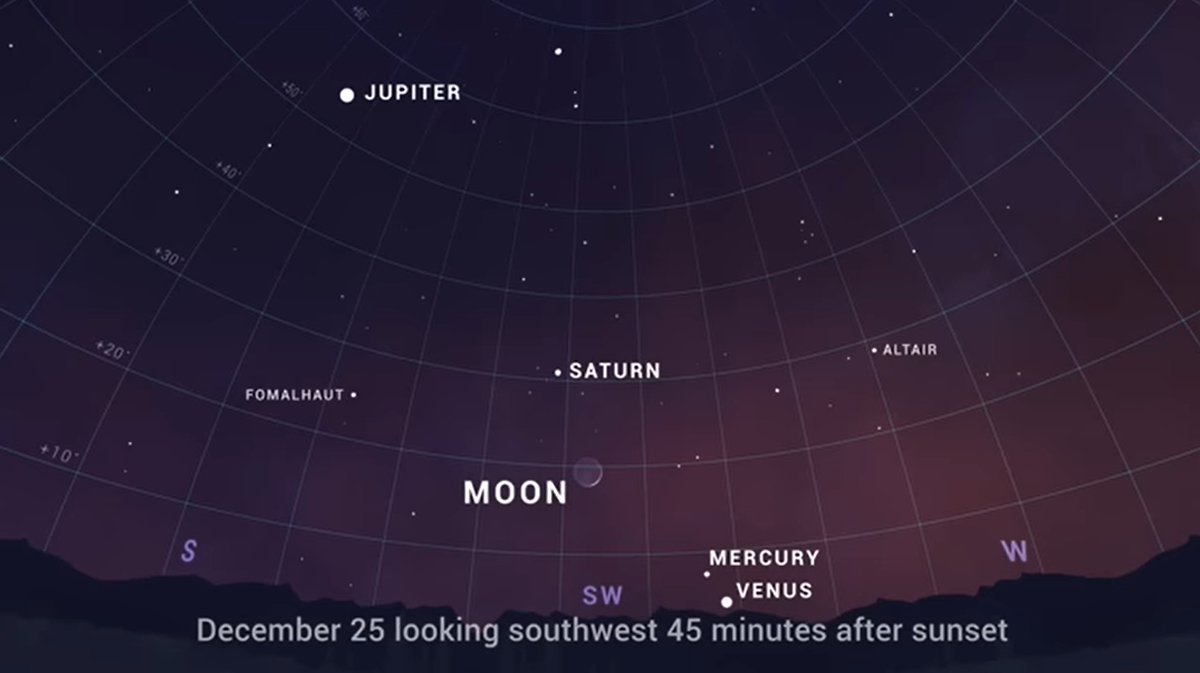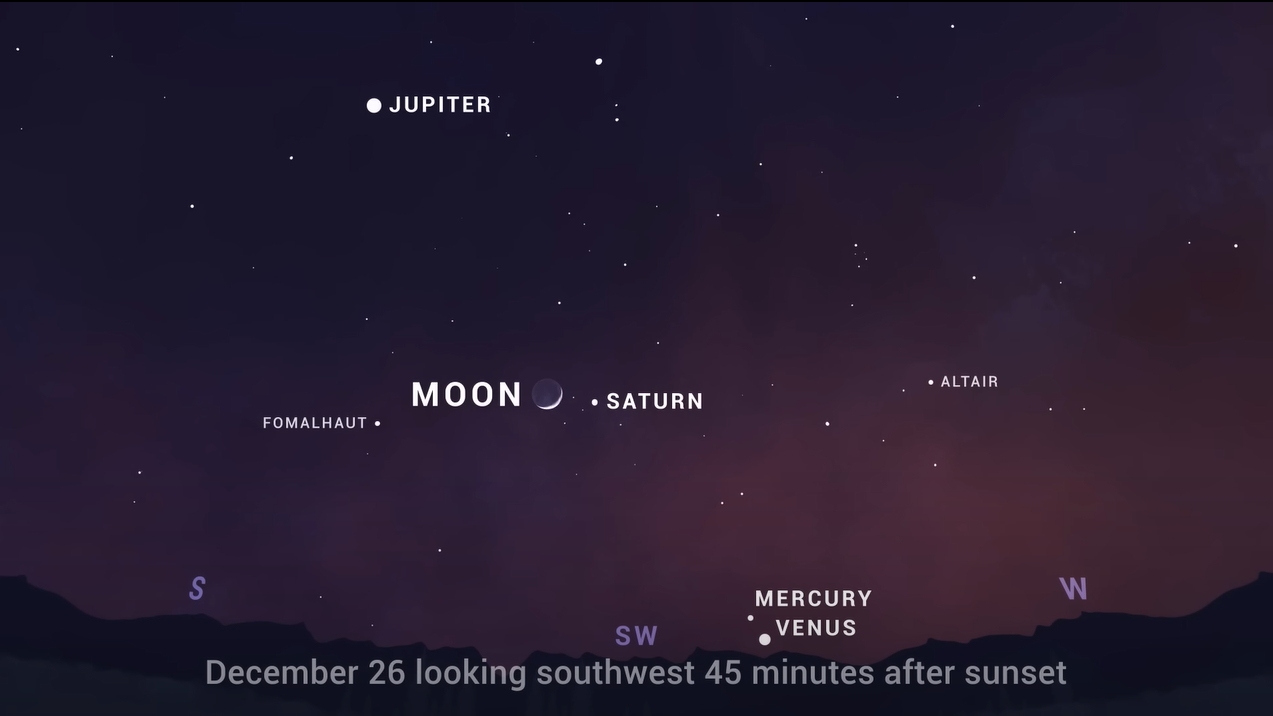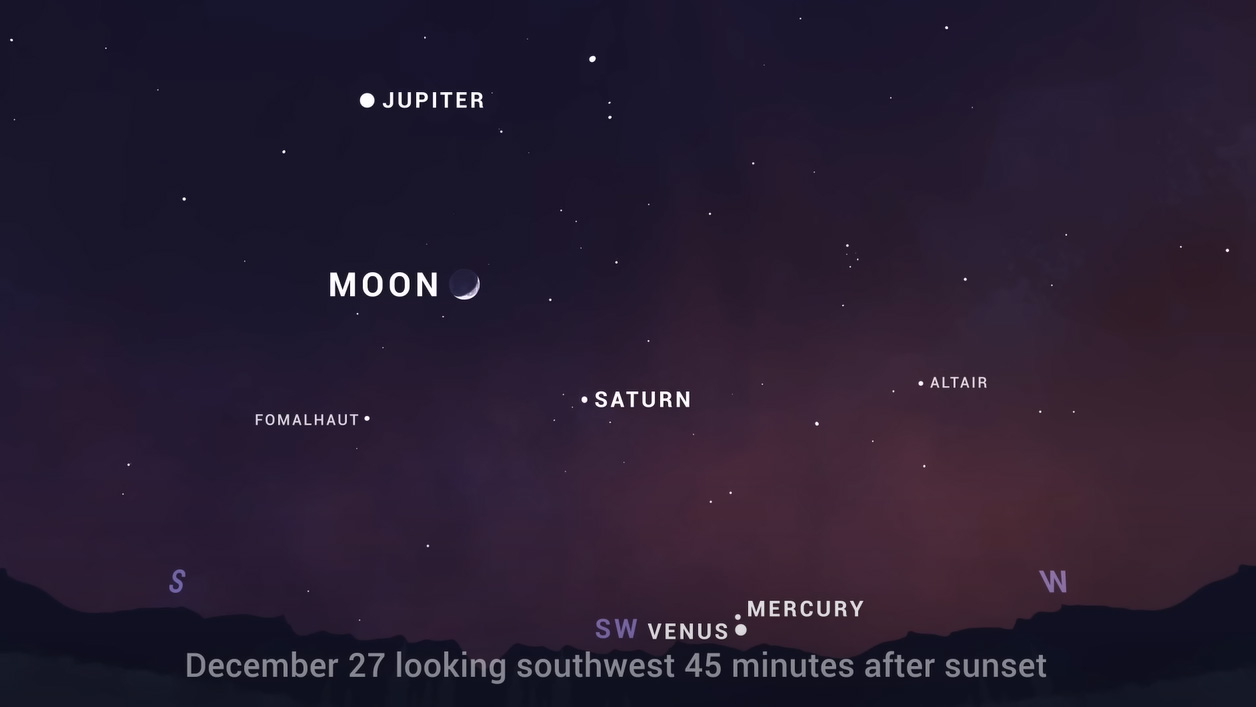See the moon and 4 planets align as Jupiter, Saturn, Mercury and Venus offer a rare night sky treat this week!
Don't miss your chance to see the moon and four planets this Christmas!
If you're looking for an awesome gift that's free this year, just look to the night sky where the Christmas moon lines up with four bright planets in a celestial holiday treat this week.
This Christmas (Dec. 25), the young crescent moon will shine with Jupiter, Saturn, Mercury and Venus and will appear to glide past Saturn and Jupiter over the next few days. All five objects will appear in a diagonal line from the south to southwest.
Related: Christmas night sky 2022: The planets pay a holiday visit

Want to get a better look at the planets or the moon? We recommend the Celestron Astro Fi 102as the top pick in our best beginner's telescope guide. Don't forget a moon filter if you'll be looking towards our celestial companion.
If your sky is clear, all you have to do is look to the southwest to see the moon, Jupiter and Saturn, which are some of the brightest objects in the night sky. If you have a clear horizon without trees or buildings, you can also see Mercury and Venus at sunset, according to a NASA guide.
"From the 25th to the 31st, look to the southwest following sunset to see an increasingly full Moon slip past Saturn and then again past Jupiter," NASA wrote in a guide. "Viewers with a clear view to the horizon will be able to search for Venus and Mercury in the fading glow of sunset, just a few degrees above the skyline."
If you're hoping to observe the moon and planets, our guides for the best telescopes and best binoculars have gear tips to help you get started. If you're looking to photograph the night sky, check out our guide on how to photograph the moon, as well our best cameras for astrophotography and best lenses for astrophotography. Read on to see how to see the moon and planets from Dec. 25 to Dec. 29 below.
Dec. 25: Christmas moon and 4 planets
The Christmas night sky show begins about 45 minutes after sunset in the southwestern sky as the moon and planets align in a diagonal pattern from south to southwest.
The two-day-old moon (the new moon was on Dec. 23) will shine as a slim crescent about 20 degrees above the horizon. Your closed fist held out at arm's length covers about 10 degrees of the night sky.
Breaking space news, the latest updates on rocket launches, skywatching events and more!
Saturn will shine above and just to the left of the moon about 30 degrees above the horizon. Jupiter, the largest of our solar system planets, will shine higher up in the night sky (just over 50 degrees above the horizon) and farther left of the moon.
Venus and Mercury are extra treats in the Christmas night sky, but may be harder to spot because they are so low in the sky, both of them less than 10 degrees above the southwest horizon.
The NASA sky map above shows how the two planets will appear with respect to the crescent moon, with Venus (the brightest planet in the night sky) shining just below and to the right of Mercury.
Dec. 26: Moon close to Saturn
Christmas may be over by Monday (Dec. 26), but the night sky will keep on giving.
Saturn and the moon will appear extra close to each other in what astronomers call a conjunction. It is the last time this year the two planets will appear so close.
The moon and Saturn can be found about 29 degrees above the southwestern horizon on Monday night, as both objects shine bright in the Capricornus constellation. While they will appear close in binoculars and to the unaided eye, they won't be close enough to see together in a telescope.
Dec. 27: Moon between Jupiter and Saturn
By Tuesday night (Dec. 27), the moon will have moved on from Saturn, but rejoins its place in the diagonal alignment with the other planets.
About 45 minutes after sunset, the crescent moon will be higher in the night sky and shine between Jupiter and Saturn, with Jupiter on top. As in earlier days this week, Mercury and Venus are visible low on the horizon.
In fact, if your visibility allows you to see all the planets, you'll see Jupiter, the moon, Saturn, Mercury and Venus line up again in a diagonal line in the sky running from down from Jupiter high in the southern sky to Venus low in the southwest.
Unlike on Christmas, when the moon was below Saturn and above Mercury, on Dec. 27 it will be above Saturn and below Jupiter.
Dec. 28: Moon below Jupiter
The moon and planet alignment continues on Wednesday (Dec. 28), with the moon shining a bit higher in the night sky.
About 45 minutes after sunset, the crescent moon will shine just below Jupiter and still be in its diagonal alignment with Saturn, Mercury and Venus. The bright stars Fomalhaut and Altair, which are visible all week, can also be seen to either side of the diagonal planet alignment.
Dec. 29: Moon above Jupiter
By Thursday (Dec. 29), the moon will move beyond Jupiter, taking its place at the top of the diagonal alignment that has dominated the southwestern night sky this week.
The phase of the moon will no longer be a crescent, with the moon reaching its quarter phase (or half moon) on Dec. 29.
At the bottom of the planet tableau, you'll see a change in order a Mercury is no longer just above Venus. During the course of this week, Mercury has shifted ever lower and on Dec. 29 it will shine just to the right of Venus, with both extremely low on the southwest horizon.
And that's a look at the moon's trip through the aligned planets of Jupiter, Saturn, Mercury and Venus this week.
Over the next few days the planets, the moon will still shine bright above the four planets as we move into a new year of skywatching.
Editor’s Note: If you snap a photograph of the moon and planets, and would like to share it with Space.com's readers, send your photo(s), comments, and your name and location to spacephotos@space.com.
Follow us on Twitter @Spacedotcom or on Facebook.

Tariq is the award-winning Editor-in-Chief of Space.com and joined the team in 2001. He covers human spaceflight, as well as skywatching and entertainment. He became Space.com's Editor-in-Chief in 2019. Before joining Space.com, Tariq was a staff reporter for The Los Angeles Times covering education and city beats in La Habra, Fullerton and Huntington Beach. He's a recipient of the 2022 Harry Kolcum Award for excellence in space reporting and the 2025 Space Pioneer Award from the National Space Society. He is an Eagle Scout and Space Camp alum with journalism degrees from the USC and NYU. You can find Tariq at Space.com and as the co-host to the This Week In Space podcast on the TWiT network. To see his latest project, you can follow Tariq on Twitter @tariqjmalik.






